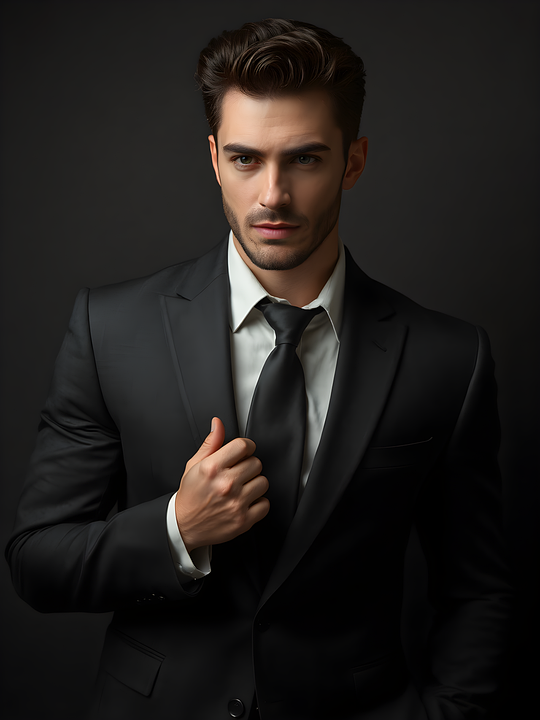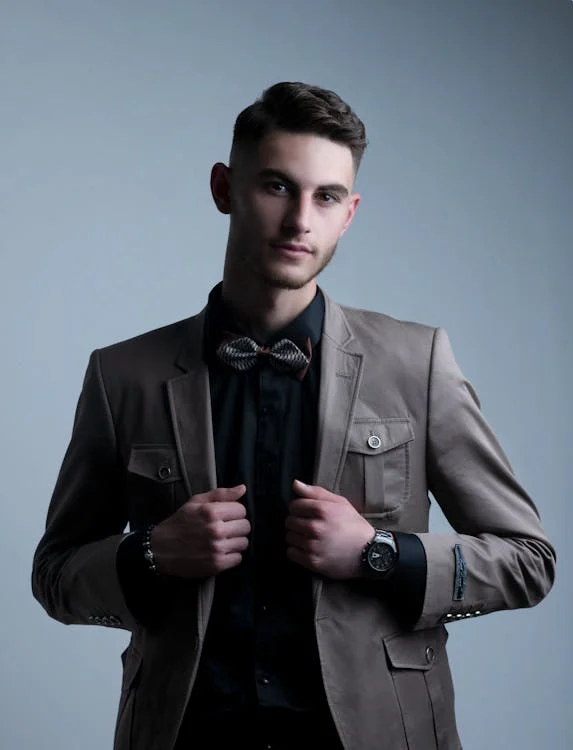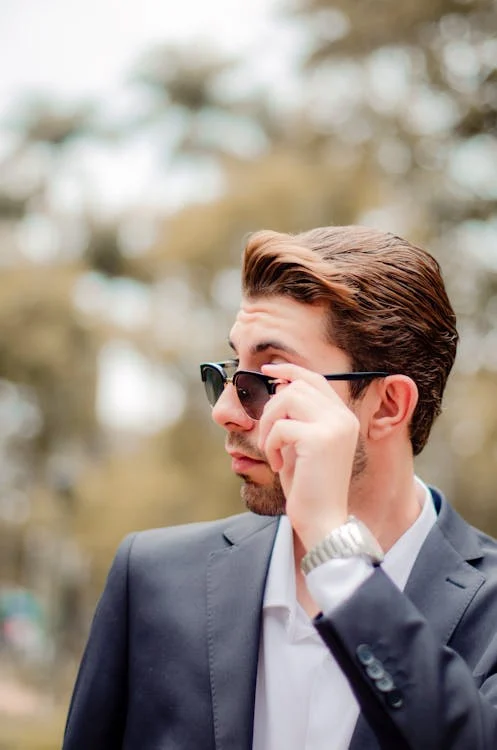Men’s formal fashion has evolved over the years, embracing both classic traditions and modern twists. Whether you’re preparing for a business meeting, attending a wedding, or looking to make a lasting impression at a gala, understanding the key components of formal menswear is essential. In this blog post, we will explore the essential elements of men’s formal fashion, including the types of formal attire, how to choose the right fabrics and colors, and key styling tips to ensure you always look your best.

1. Understanding the Different Types of Formal Attire
The first step in mastering men’s formal fashion is knowing the different categories of formal attire. While many people think of a tuxedo when they hear the word “formal,” there are several different looks that fall under this broad category. Here are the main types of formal attire men might encounter:
a. Black Tie
The black-tie dress code is the most common and recognizable form of formal attire. It is typically worn for evening events such as galas, weddings, and charity dinners. The black-tie outfit consists of:
- Tuxedo: A black or midnight blue dinner jacket with satin or grosgrain lapels.
- Black Dress Pants: Typically featuring a satin or silk stripe down the side to match the jacket’s lapels.
- White Dress Shirt: Usually a crisp white shirt with a pleated front or a smooth design, often with a wingtip collar.
- Black Bow Tie: A silk or satin bow tie is a must for this look.
- Black Patent Leather Shoes: Polished formal shoes are essential, with Oxford-style being the most classic choice.
- Accessories: Cufflinks, a pocket square, and a dress watch are optional but add sophistication.
b. White Tie
White tie is the most formal attire you can wear and is typically reserved for state dinners, royal events, or prestigious galas. This outfit is even more elaborate than the black tie. It includes:
- Tailcoat: A black coat with a cutaway front and long tails in the back.
- Formal White Shirt: A white dress shirt with a stiff, high collar and a bib front.
- White Bow Tie: A white silk bow tie.
- Formal Black Dress Pants: High-waisted trousers, typically without cuffs.
- Black Patent Leather Shoes: Similar to black tie but more polished and formal.
- Accessories: A white pocket square, cufflinks, and possibly a top hat or gloves for extra formality.
c. Business Formal
Business formal attire is common for corporate meetings, presentations, and professional events. While it shares similarities with black-tie, it is typically less ornate and more conservative. The key components are:
- Suit: A well-tailored suit in solid colors like navy, charcoal, or black. Two-piece or three-piece options are common.
- Dress Shirt: A well-fitted button-down shirt, typically in white, light blue, or pale shades.
- Tie: A silk tie in a conservative pattern or color—solid or striped works best.
- Leather Shoes: Oxfords, brogues, or derbies in black or brown.
- Accessories: A leather belt matching your shoes, cufflinks, and a simple watch are appropriate.
d. Cocktail Attire
Cocktail attire lies between formal and semi-formal and is often seen at social events like evening parties or informal weddings. A more relaxed version of the tuxedo or suit, cocktail attire typically includes:
- Suit or Blazer: A dark suit or a blazer paired with dress trousers. You can experiment with colors or textures like velvet or tweed.
- Shirt: A sharp dress shirt with or without a tie, depending on the formality of the event.
- Footwear: Black or brown leather shoes, such as loafers or dress boots.
- Accessories: A pocket square or tie bar for a dash of personality.
2. Fabric Choices for Men’s Formal Wear
The choice of fabric plays a huge role in determining the overall quality, comfort, and sophistication of your formal look. Here’s an overview of the most common fabrics used in formal menswear:
a. Wool
Wool is the most classic and versatile fabric for formal attire. It is durable, breathable, and ideal for both summer and winter wear. Wool suits are often lined, providing structure and crispness. Super 100s to Super 150s wool is a popular choice for luxury suits, but a more affordable alternative is wool blends with polyester or spandex for stretch.
b. Tweed
Tweed is a heavier fabric commonly used for autumn and winter wear. This woolen fabric is typically woven with a rough texture, which gives it a distinguished look. A tweed suit can add a sophisticated edge to your formal ensemble, especially for more casual or semi-formal occasions.
c. Cotton
Cotton is more common in summer formalwear, particularly for less structured suits and blazers. It’s lighter than wool and more breathable but lacks the luxurious feel of finer fabrics. Cotton suits tend to wrinkle more easily but can provide a cool and comfortable option for daytime events.
d. Silk
Silk is used primarily for accessories, such as ties, pocket squares, and bow ties. It’s a luxurious fabric with a smooth and shiny finish that works well with evening events. While a full silk suit is rare, silk can be mixed with other fibers like wool for a refined look.
e. Linen
Linen is a lightweight, breathable fabric, ideal for warmer climates or daytime events. Though it offers an elegant appearance, it is prone to wrinkling, which is part of its relaxed charm. Linen suits in light colors, such as beige or pale blue, are perfect for summer weddings and outdoor formal events.
3. Color Selection for Formal Attire
The colors you choose for formal occasions say a lot about your style and how well you understand the event’s tone. Here’s a breakdown of common color choices in men’s formal fashion:
a. Black
The classic black tuxedo is the epitome of formality. Black is sleek, elegant, and always appropriate for formal occasions. It’s a versatile color that can be paired with a variety of shirt and accessory colors. However, black suits are often reserved for evening events or those requiring a high level of formality.
b. Navy Blue
Navy blue is an excellent alternative to black, offering a rich, refined look that works for both business and formal wear. It’s more adaptable to daytime events, and the depth of the blue adds an air of sophistication.
c. Charcoal Gray
Charcoal gray is another timeless and versatile color for suits. It exudes professionalism and is ideal for business formal occasions, though it can also be dressed up for evening events. Lighter shades of gray are good for more relaxed formal occasions.
d. White or Cream
White suits are often reserved for summer or tropical settings, but they can be an attention-grabbing option for weddings and other daytime events. Cream-colored jackets or shirts are perfect for a softer, less formal look while still maintaining elegance.
e. Muted Shades and Pastels
For a modern twist, muted tones and pastel colors have been increasingly seen in men’s formal fashion. Soft colors like light blue, sage, or blush can add a refreshing twist to your look without compromising sophistication. These colors work best for spring and summer events.
4. Key Accessories to Elevate Your Formal Look
Accessories can take your formal look to the next level, adding both personality and elegance to your outfit. Here are some accessories to consider:
a. Ties and Bow Ties
A well-chosen tie or bow tie can make or break your outfit. For formal events, opt for silk ties in solid colors, stripes, or subtle patterns. Bow ties are an essential part of black-tie and white-tie attire, usually in black, but they can also be worn in different colors or patterns for a less traditional look.
b. Cufflinks
Cufflinks are an elegant addition to formal shirts, particularly those with French cuffs. Silver or gold cufflinks are the most classic choices, but you can find unique designs to match your personality or event.
c. Pocket Squares
A pocket square adds a pop of color and sophistication to your suit jacket. White is always a safe choice, but patterned or colored pocket squares can add flair. Ensure your pocket square complements, but does not match, your tie.
d. Dress Watches
A simple, elegant watch with a leather or metal band is a timeless accessory that adds class to any formal look. Avoid anything too flashy or sporty, and opt for a minimal design that complements your overall style.
5. Final Thoughts on Men’s Formal Fashion
Mastering men’s formal fashion is about paying attention to detail and making sure every element of your outfit is in harmony. Whether you’re dressing for a black-tie gala or a business meeting, understanding the nuances of fabric, fit, color, and accessories will ensure you look polished, professional, and confident. When in doubt, always err on the side of classic styles, as they’re timeless and will never go out of fashion. With the right attention to detail and careful planning, you’ll be able to make a statement in any formal setting.
Lorem ipsum dolor sit amet, consectetur adipiscing elit. Ut elit tellus, luctus nec ullamcorper mattis, pulvinar dapibus leo.











